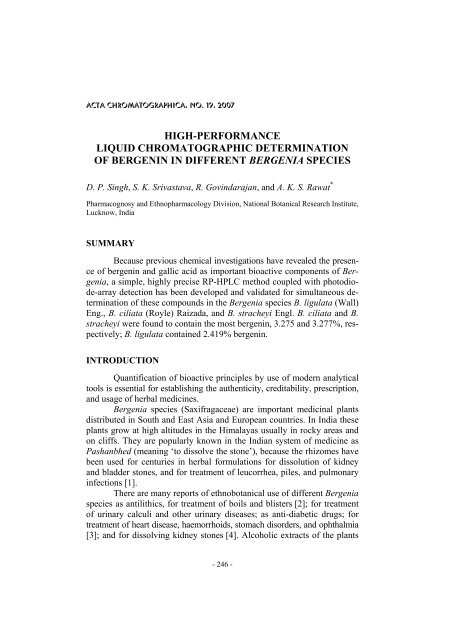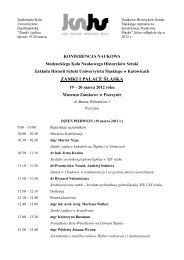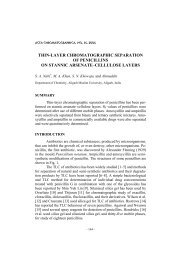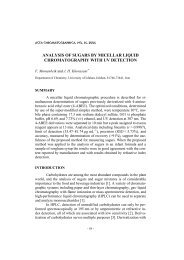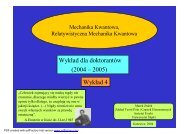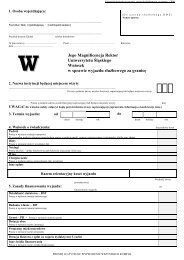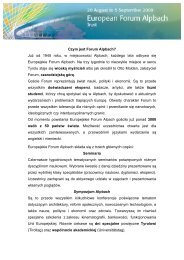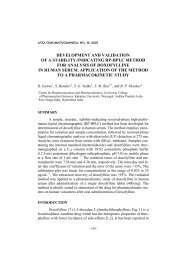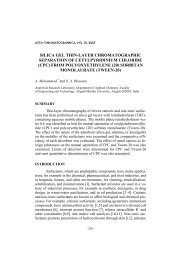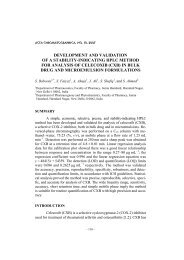High-performance liquid chromatographic determination of bergenin ...
High-performance liquid chromatographic determination of bergenin ...
High-performance liquid chromatographic determination of bergenin ...
Create successful ePaper yourself
Turn your PDF publications into a flip-book with our unique Google optimized e-Paper software.
have been shown to have analgesic, anti-inflammatory, and diuretic properties[5]. Other pharmacological claims include antibacterial [6], antiinflammatory[7], and anti-tussive activity <strong>of</strong> B. ciliata [8], and anti-viral[9] and antilithiatic [10] activity.Previous chemical investigations <strong>of</strong> these plants have revealed thepresence <strong>of</strong> β-sitosterol-D-glucoside [11], <strong>bergenin</strong> [12], α-afzelechin [13],leucocyanidin, gallic acid [14], methyl gallate, catechin [15], and pashaanolactone[16]. Bergenin is reported to have anti-inflammatory [17], antitussive[18], anti-HIV [19], antiarrhythmic [20], and neuroprotective [21] activity.Because <strong>of</strong> their great importance it is important to identify whichBergenia species contain most <strong>bergenin</strong>, so the most potent plant speciesis used in herbal formulations and has the strongest desired effect. A simpleand highly precise RP-HPLC method with photodiode-array (PDA) detectionhas therefore been developed and validated for simultaneous analysis<strong>of</strong> the bioactive molecules <strong>bergenin</strong> and gallic acid in three different Bergeniaspecies, viz. B. ligulata (Wall) Eng., B. ciliata (Royle) Raizada, andB. stracheyi Engl. The method can also be used for quality control andstandardization <strong>of</strong> the species, to identify the species used in a formulation.EXPERIMENTALChemicalsBergenin and gallic acid were obtained from Sigma–Aldrich (Steinheim,Germany). HPLC-grade acetonitrile, water, and phosphoric acid werefrom Merck (Darmstadt, Germany).Plant Material and ExtractionRhizomes <strong>of</strong> three different Bergenia species, B. ligulata (Wall)Eng., B. ciliata (Royle) Raizada, and B. stracheyi Engl. were collectedfrom Almora (Uttracnhal, India). The specimens were authenticated and avoucher specimen <strong>of</strong> each (LWG 222437BC; LWG 222438BL; LWG222439BS, 2004) was deposited in a herbarium. Samples <strong>of</strong> air-dried (45–55°C) powdered rhizome from the three Bergenia species (1.0 g) wereextracted with 3 × 10 mL methanol. The extracts from each species wereseparately combined, concentrated by rotary evaporation (Büchi, USA) atlow temperature (45°C), and then freeze-dried (Freezone 4.5; Labconco,USA) under high vacuum (133 × 10 4 mBar) at −40 ± 2°C to furnish resi-- 247 -
dues equivalent to 5.0, 8.833, and 13.83%, respectively, <strong>of</strong> the dry mass <strong>of</strong>the original plant sample.To identify peaks present in the blank mobile phase was treated inthe same way.Qualitative and Quantitative HPLC Analysis <strong>of</strong> BergeninChromatography was performed with Waters (Milford, MA, USA)515 pumps, an online degasser, a Waters pump-control module, a Rheodyne7725 injection valve with a 20-µL loop, a Waters 2996 photodiodearray detector, and Waters Empower s<strong>of</strong>tware. Compounds were separatedon a 150 mm × 3.6 mm i.d., 5-µm particle, Waters Symmetry column protectedby a guard column <strong>of</strong> the same type.An HPLC fingerprint pr<strong>of</strong>ile was established for the phenolic fraction.Elution was performed at a flow rate <strong>of</strong> 1 mL min −1 with a gradientprepared from water–phosphoric acid 99.7:0.3 (v/v) (component A) andacetonitrile–water–phosphoric acid 79.7:20:0.3 (v/v) (component B). The gradientwas: 0–5 min, 88–85% A; 5–10 min, 85–75% A; 10–20 min, 75–70%A. Typical chromatograms obtained under these conditions are shown inFig. 1.CalibrationThe amounts <strong>of</strong> the active compounds were determined by use <strong>of</strong>calibration plots established by chromatography <strong>of</strong> gallic acid and <strong>bergenin</strong>standards at seven different concentrations ranging from 2.5 to 200 µg mL –1 .Each solution was chromatographed in triplicate. The corresponding peakareas were plotted against the concentration <strong>of</strong> the phenolic compound injected.Peaks were identified by comparison <strong>of</strong> retention times and UVabsorption spectra with those <strong>of</strong> standards.ValidationSelectivity and Peak PuritySelectivity was checked by using an extract <strong>of</strong> Bergenia species anda mixture <strong>of</strong> available standards and optimizing separation and detection.The purity <strong>of</strong> the peaks was checked by acquisition <strong>of</strong> spectra (λ = 200–400 nm) by use <strong>of</strong> the PDA detector and use <strong>of</strong> multivariate analysis.Spectra were acquired at the upslope, apex, and downslope <strong>of</strong> each peak,computer normalized, and superimposed. Peaks were considered pure whenthere was coincidence between the three spectra (match factor ≥98%).- 248 -
2.001StdAU1.0020.000.100.00 5.00 10.00 15.00 20.00 25.00Minutes2BCAU0.0510.000.150.00 5.00 10.00 15.00 20.00 25.00Minutes2BS0.10AU0.0510.000.140.120.100.080.00 5.00 10.00 15.00 20.00 25.00Minutes2BLAU0.060.040.020.001Fig. 1-0.020.00 5.00 10.00 15.00 20.00 25.00MinutesChromatograms obtained from Bergenia species (Std, standard; BC, B. ciliate; BS, B. stracheyi;BL, B. ligulata) at 272 showing 1, gallic acid; 2, <strong>bergenin</strong>- 249 -
Linearity, and Limits <strong>of</strong> Detection and QuantificationThe linearity <strong>of</strong> the detector response for the standards was assessedby linear regression analysis <strong>of</strong> the amounts <strong>of</strong> each standard (µg) andthe area <strong>of</strong> the corresponding peak on the chromatogram. Linearity wasalso confirmed for extracts. After <strong>chromatographic</strong> separation, the peakareas obtained were plotted against extract concentration by linear regressionanalysis.Limits <strong>of</strong> detection and quantification were determined as the amountsfor which the calculated signal-to-noise ratios were approximately 3:1 and10:1, respectively.StatisticsWhen applicable, one-way or two-way analysis <strong>of</strong> variance (SPSS11.0 for Windows) was used to assess the observed differences in phenoliccontent. Differences were considered to be statistically significant whenthe P value was
elution were not observed (match factors ≥95%). Linearity and limits <strong>of</strong>detection (LOD) and quantification (LOQ) were evaluated for quantitativepurposes (Table II). LOD for <strong>bergenin</strong> and gallic acid were 1.16 and 0.66µg mL −1 and LOQ were 3.9 and 4.2 µg mL −1 , respectively, implying themethod was suitable for quantification <strong>of</strong> these compound. R 2 values forthe compounds were >0.98, confirming the linearity <strong>of</strong> the method. Themethod can therefore be regarded as suitable for quality control and standardization<strong>of</strong> Bergenia species.Table IIRetention times, correlation coefficients and linear range from regression analysis, andlimits <strong>of</strong> quantification (LOQ) and detection (LOD)Compound t R (min) a R 2 Linear range LOD LOQ(µg mL −1 ) (µg mL −1 ) (µg mL −1 )Gallic acid 5.91 ± 0.12 0.990 10–200 0.66 4.2Bergenin 11.06 ± 0.23 0.957 5–50 1.16 3.9a Means from ten replicates ± SDThese results suggest B. ciliata and B. stracheyi are better sources<strong>of</strong> <strong>bergenin</strong> than B. ligulata and that their biological activity will be greater.ACKNOWLEDGEMENTThe authors are grateful to Dr Rakesh Tuli, Director, NBRI forproviding the facilities to conduct this research work.REFERENCES[1] L.V. Asolkar, K.K. Kakkar, and O.J. Chakre, Glossary <strong>of</strong> IndianMedicinal Plants with Active Principles. PID, CSIR, New Delhi,1992, p. 122[2] K.K. Singh, Indian Int. J. Pharmacol., 35, 105 (1997)[3] S.K. Kapur, J. Econ. Tax. Bot., 17, 395 (1993)[4] P.B. Singh and B.S. Aswal, Bull. Med. Ethnobot. Res.,13, 172 (1992)- 251 -
[5] N.K. Gehlot, V.N. Sharma, and D.S. Vyas, Indian. J. Pharmacol.,8, 92 (1976)[6] S. Sinha, T. Murugesan, K. Maiti, J.R. Gayen, B. Pal, M. Pal,and B.P. Saha, Fitoterapia, 72, 550 (2001)[7] S. Sinha, T. Murugesan, K. Maiti, J.R. Gayen, B. Pal, M. Pal,and B.P. Saha, J. Pharm. Pharmacol., 53, 193 (2001)[8] S. Sinha, T. Murugesan, M. Pal, and B.P. Saha, Phytomedicine,8, 298 (2001)[9] M. Rajbhandari, U. Wegner, M. Julich, T. Schopke, and R. Mentel,J. Ethnopharmacol., 74, 251 (2001)[10] T.S. Garimella, C.I. Jolly, and S. Narayanan, Phytother. Res.,15, 351 (2001)[11] M.K. Jain and K. Gupta, J. Indian Chem. Soc., 39, 559 (1962)[12] C.P. Baht, R. Murari, M.R. Parthasarathy, and T.R. Seshadri, IndianJ. Chem., 12, 1038 (1974)[13] A.P. Tucci, M.F. Delle, B. Marini, and B. Giovanni, Ann. SuperSanita., 5, 555 (1969)[14] S.K. Chauhan, B. Singh, and S. Agrawal, JAOAC Int.,83, 1480 (2000)[15] B.S. Dixt and S.N. Srivastava, Indian J. Nat. Prod., 5, 24 (1989)[16] U.D. Chandra Reddy, A.S. Chawla, D. Mundkinajeddu, R. Maurya,and S.S. Handa, Phytochemistry, 47, 907 (1998)[17] T. Swarnalakshmi, M.G. Sethuraman, N. Sulochana,and R. Arivudainambi, Curr. Sci., 53, 917 (1984)[18] X. Piegen, Traditional Experience <strong>of</strong> Chinese Herb Medicine. ItsApplications in Drug Research and New Drug Searching.In: J.L. Beal, E. Reinhard (Eds) Natural Products as MedicinalAgents, Hippokrates, Stuttgart, 1980[19] S. Piacente, C. Pizza, and N. Detommasi., J. Nat. Prod.,59, 565 (1996)[20] H.L. Pu, X. Huang, J.H. Zhao, and A. Hing, Planta Med.,68, 372 (2002)[21] H. Takahashi, M. Kosaka, Y. Watanabe, K. Nakade,and Y. Fukuyama, Bioorg. Med. Chem., 11, 1781 (2003)- 252 -


